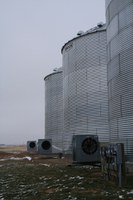Keep Stored Grain Cool During Spring and Summer
(Click the image below to view a high-resolution image that can be downloaded)
Keeping stored grain cool is important as outdoor temperatures fluctuate and eventually start to warm this spring, a North Dakota State University Extension Service grain storage expert advises.
“Not only will daytime temperatures be increasing, but the bin works as a solar collector,” Extension agricultural engineer Ken Hellevang says.
More heating occurs on the south wall of a grain bin on March 1 than during the middle of the summer.
“This heats the grain next to the bin wall to temperatures exceeding average outside temperatures,” Hellevang says. “This is of more concern if the grain exceeds recommended storage moisture contents.”
He recommends producers run the aeration fans periodically during the spring to keep the grain temperature cool, preferably near 30 F in the northern part of the country during March and April, and below 40 F in southern regions. Nighttime temperatures typically are near or below 30 F in March and below 40 F in April across the north-central region of the U.S.
“Temperature sensors are an excellent tool, but remember that they only measure the temperature of the grain next to the sensor,” Hellevang says. “Because grain is an excellent insulator, the grain temperature may be much different just a few feet from the sensor and not affect the measured temperature.”
He encourages placing a temperature cable a few feet from the south wall of a bin.
Aeration fans or ducts should be covered when not operating. The wind and a natural chimney effect will push warm, moist spring air through the grain. If the wind blows primarily during the daytime, the grain will be warmed to the daily maximum temperature. Typical maximum temperatures, even in northern states in late March, are in the mid-40s and increase in late April to around 60 F. Also, grain moisture will increase as the grain is warmed.
“The goal for summer storage should be to keep the grain as cool as possible to limit insect activity,” Hellevang says. “Insect reproduction is reduced at temperatures below about 60 F.”
Provide an air inlet near the bin roof eave and an outlet near the peak to reduce the hot air in the top of the bin. Similar to venting an attic, the heated air rises and is exhausted at the peak.
A ventilation fan to exhaust the hot air is another option. Hot air under the bin roof will heat several feet of grain at the top of the bin to temperatures conducive for insect infestations. Running the aeration fan for a few hours to push air up through the cool stored grain will cool grain near the top.
Pick a cool morning every two to three weeks during the summer to run the aeration fan, and only run the fan a few hours to minimize heating grain at the bottom of the bin. Cover the fan when it is not operating to prevent additional heating of the grain.
Having grain at an appropriate warm-season storage moisture content is very important to store grain safely during the summer, according to Hellevang. The maximum moisture content for warm-season storage is 13 to 14 percent for corn, 11 percent for soybeans, 13.5 percent for wheat, 12 percent for barley and 8 percent for oil sunflowers.
Mold growth will occur at summer temperatures if the grain exceeds the recommended moisture content. The allowable storage time for 15 percent moisture corn is only about four months at 70 degrees and two months at 80 degrees.
Checking the grain moisture content is important because moisture measurements at harvest may have been in error due to moisture gradients in the kernel, grain temperature and other factors. In addition, the moisture may have changed while the grain was in storage due to moisture migration or moisture entering the bin.
When checking the moisture content, follow the moisture meter manufacturer’s procedure for obtaining an accurate moisture measurement. Temperature adjustments, cold grain, inaccurate sample quantity and moisture variations across the kernel frequently cause substantial measurement errors.
Verify the accuracy of the measurement by warming the grain sample to room temperature in a sealed plastic bag before measuring the moisture content. A period of six to 12 hours in a sealed container also permits grain moisture to reach equilibrium across the kernels. Compare the on-farm measured value to that of the sample using a meter at the elevator or other market location.
Hellevang suggests checking the stored grain at least every two weeks. While checking on the grain, measure and record the grain temperature and moisture content. Rising grain temperature may indicate insect or mold problems. Insect infestations can increase from being barely noticeable to major infestations in three to four weeks when the grain is warm.
“Grain temperature cables are a wonderful tool, but do not rely on them to replace inspecting for insects or crusting and detecting odors or other indicators of storage problems,” he says.
Visit NDSU’s grain drying and storage website at https://www.ag.ndsu.edu/graindrying for more information.
NDSU Agriculture Communication - Feb. 20, 2018
| Source: | Ken Hellevang, 701-231-7243, kenneth.hellevang@ndsu.edu |
|---|---|
| Editor: | Ellen Crawford, 701-231-5391, ellen.crawford@ndsu.edu |


